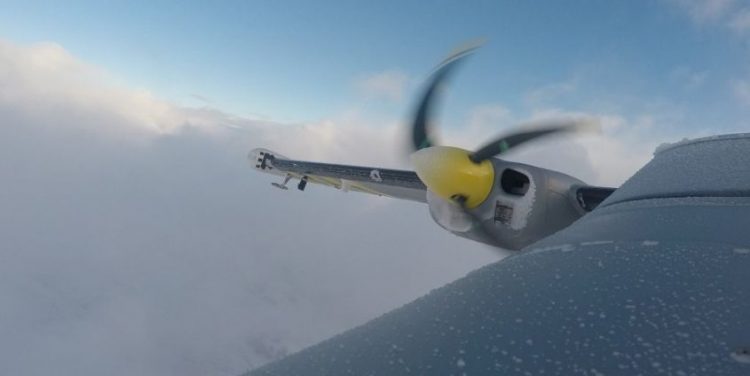New technology to determine ice on aircraft

Copyright: Airborne Technologies
When flights take place during bad weather conditions, planes inevitably spend extended periods flying through the cloud layer.
With exterior temperatures below freezing – given the typical flight altitudes, this is frequently the case, even during the summer months – a dangerous process of ice formation can take place on the wings of the aircraft. This may have a negative effect on the flight characteristics, even leading to the aircraft crashing in extreme cases.
Researchers have now developed a sensor system that offers assistance with the detection of ice formation. The technology is based on sensors similar to those used on the blades of wind turbines.
One of the innovative aspects lies in the design of the new sensors, which are significantly thinner and can therefore be better adapted to the aerodynamics of an aircraft. “The sensors measure the temperature and the degree of icing and wirelessly transmit this information to a receiving unit in the cockpit”, Hubert Zangl explains. He was the University of Klagenfurt (Institute of Smart Systems Technology) representative working on this project.
The project team focused intensively on the thermal behaviour of the sensor, on the interactions with other components such as the heating elements, and on the accuracy of the temperature measurements taken on the wing surface.
Another part of the project was devoted to achieving greater precision in the measurement of air stream on the surface and to performing simulations of the ice formation process. The construction of the antennae, required to ensure the best possible radio contact to the receiving unit, represented a particular challenge.
Funded by the Austrian Research Promotion Agency (FFG), the project was carried out jointly with eologix sensor technology gmbh, FH JOANNEUM GmbH (Institute of Electronic Engineering) and Villinger GmbH (de-icing systems for the aviation industry).
Testflights were carried out by Airborne Technologies. According to Hubert Zangl, the insights gained can be used in numerous different fields: “The sensor is flexible in terms of its installation and dimension, and consequently it is suitable for use in a vast range of situations.”
Univ.-Prof. Dipl.-Ing. Dr. Hubert Zangl
+43 463 2700 3562
Hubert.Zangl@aau.at
Media Contact
More Information:
http://www.aau.atAll latest news from the category: Power and Electrical Engineering
This topic covers issues related to energy generation, conversion, transportation and consumption and how the industry is addressing the challenge of energy efficiency in general.
innovations-report provides in-depth and informative reports and articles on subjects ranging from wind energy, fuel cell technology, solar energy, geothermal energy, petroleum, gas, nuclear engineering, alternative energy and energy efficiency to fusion, hydrogen and superconductor technologies.
Newest articles

High-energy-density aqueous battery based on halogen multi-electron transfer
Traditional non-aqueous lithium-ion batteries have a high energy density, but their safety is compromised due to the flammable organic electrolytes they utilize. Aqueous batteries use water as the solvent for…

First-ever combined heart pump and pig kidney transplant
…gives new hope to patient with terminal illness. Surgeons at NYU Langone Health performed the first-ever combined mechanical heart pump and gene-edited pig kidney transplant surgery in a 54-year-old woman…

Biophysics: Testing how well biomarkers work
LMU researchers have developed a method to determine how reliably target proteins can be labeled using super-resolution fluorescence microscopy. Modern microscopy techniques make it possible to examine the inner workings…





















